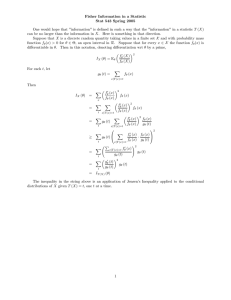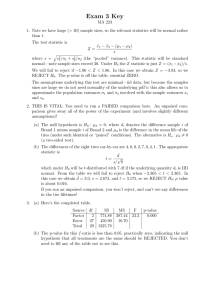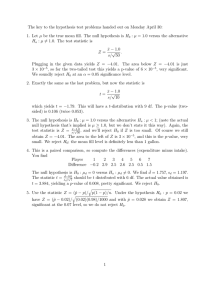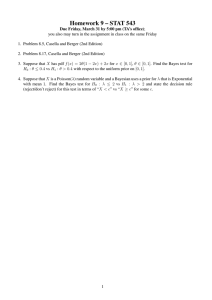14.30 Introduction to Statistical Methods in Economics
advertisement
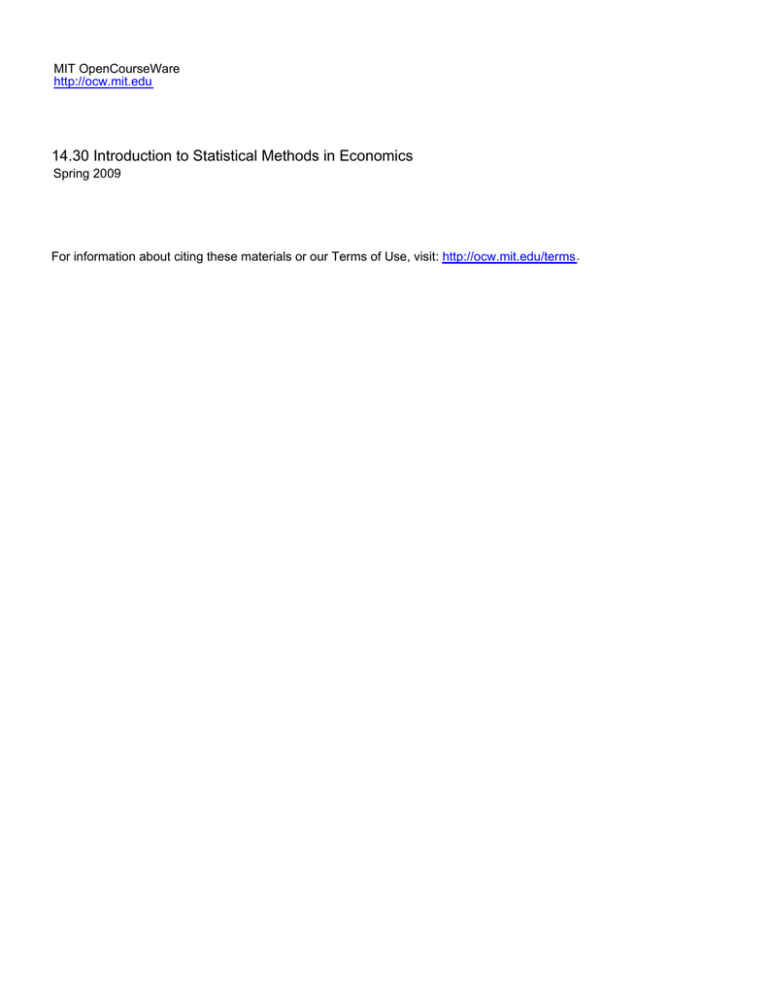
MIT OpenCourseWare
http://ocw.mit.edu
14.30 Introduction to Statistical Methods in Economics
Spring 2009
For information about citing these materials or our Terms of Use, visit: http://ocw.mit.edu/terms.
14.30 Introduction to Statistical Methods in Economics
Lecture Notes 23
Konrad Menzel
May 12, 2009
1
Examples
Example 1 Assume that babies’ weights (in pounds) at birth are distributed according to X ∼ N (7, 1).
Now suppose that if an obstetrician gave expecting mothers poor advice on diet, this would cause babies
to be on average 1 pound lighter (but have same variance). For a sample of 10 live births, we observe
X̄10 = 6.2.
• How do we construct a 5% test of the null that the obstetrician is not giving bad advice against the
alternative that he is? We have
H0 : µ = 7 against HA : µ = 6
We showed that for the normal distribution, it is optimal to base this simple test only on the sample
¯ 10 , so that T (x) = x̄10 . Under H0 , X
¯ 10 ∼ N (7, 0.1) and under HA , X
¯ 10 ∼ N (6, 0.1). The
mean, X
test rejects H0 if X̄10 < k. We therefore have to pick k in a way that makes sure that the test has
size 5%, i.e.
�
�
k−7
0.05 = P (X̄10 < k|µ = 7) = Φ √
0.1
where Φ(·) is the standard normal c.d.f.. Therefore, we can obtain k by inverting this equation
k =7+
√
1.645
0.01Φ−1 (0.05) ≈ 7 − √
≈ 6.48
10
Therefore, we reject, since X̄10 = 6.2 < 6.48 = k.
• What is the power of this test?
¯ 10 < 6.48|µ = 6) = Φ
P (X
�
6.48 − 6
√
0.1
�
≈ Φ(1.518) ≈ 93.55%
• Suppose we wanted a test with power of at least 99%, what would be the minimum number n of
newborn babies we’d have to observe? The only thing that changes with n is the variance of the
√ , whereas the
sample mean, so from the first part of this example, the critical value is kn = 7 − 1.645
n
¯
power of a test based on Xn and critical value kn is
�
�√
¯ n < kn |µ = 6) = Φ n − 1.645
1 − β = P (X
1
Setting 1 − β ≥ 0.99, we get the condition
√
n − 1.645 ≥ Φ−1 (0.99) = 2.326 ⇔ n ≥ 3.9712 ≈ 15.77
This type of power calculations is frequently done when planning a statistical experiment or survey
- e.g. in order to determine how many patients to include in a drug test in order to be able to detect
an effect of a certain size. Often it is very costly to treat or survey a large number of individuals,
so we’d like to know beforehand how large the experiment should be so that we will be able to detect
any meaningful change with sufficiently high probability.
Example 2 Suppose we are still in the same setting as in the previous example, but didn’t know the
variance. Instead, we have an estimate S 2 = 1.5. How would you perform a test? As we argued earlier,
the statistic
X̄n − µ0
√
T :=
∼ tn−1
S/ n
is student-t distributed with n − 1 degrees of freedom if the true mean is in fact µ0 . Therefore we reject
H0 if
X̄n − 7
√ < t9 (5%)
T =
S/ 10
Plugging in the values from the problem, T = − √ 0.8
1.5/10
≈ −2.066, which is smaller than t9 (0.05) = −1.83.
Example 3 Let Xi ∼ Bernoulli(p), i = 1, 2, 3. I.e. we are flipping a bent coin three times independently,
and Xi = 1 if it comes up heads, otherwise Xi = 0. We want to test H0 : p = 13 against HA : p = 32 .
Since both hypotheses are simple, can use likelihood ratio test
P3
�3 � 1 �Xi � 2 �1−Xi
P3
f0 (X)
23− i=1 Xi
i=1 3
3
T =
= �3 � �Xi � �1−Xi = P3 X = 23−2 i=1 Xi
2
1
fA (X)
2 i=1 i
i=1 3
3
Therefore, we reject if
23−2
P3
i=1
Xi
≤ k ⇔ (3 − 2
3
�
i=1
Xi ) log 2 ≤ log k
k
which is equivalent to X̄3 ≥ 12 − 6log
log 2 . In order to determine k, let’s list the possible values of X̄3 and
their probabilities under H0 and HA , respectively:
X̄3
1
2
3
1
3
0
Prob. under H0
1
27
6
27
12
27
8
27
Prob. under HA
8
27
12
27
6
27
1
27
cumul. prob. under H0
1
27
7
27
19
27
1
1
, we could reject if and only if X̄3 > 32 , or equivalently
So if we want the size of the test equal to α = 27
1
we can pick k = 2 . The power of this test is equal to
¯ 3 = 1|HA ) = 8 ≈ 29.63%
1 − β = P (X
27
2
Example 4 Suppose we have one single observation generated by either
�
�
2 − 2x
2x
if 0 ≤ x ≤ 1
f0 (x) =
or fA (x) =
0
0
otherwise
if 0 ≤ x ≤ 1
otherwise
• Find the testing procedure which minimizes the sum of α+β - do we reject if X = 0.6? Since we only
have one observation X, it’s not too complicated to write the critical region directly in terms of X,
and there is nothing to be gained by trying to find some clever statistic (though of course NeymanPearson would still work here). By looking at a graph of the densities, we can convince ourselves
that the test should reject for small values of X < k for some critical level k. The probability of
type I and type II error is, respectively,
� k
α(k) = P (reject|H0 ) =
2xdx = k2
0
for 0 ≤ k ≤ 1, and
β(k) = P (don’t reject|HA ) =
�
k
1
(2 − 2x)dx = 2(1 − k) − 1 + k2 = 1 − k(2 − k)
Therefore, minimizing the sum of the error probabilities over k,
min{α(k) + β(k)} = min{k2 + 1 − k(2 − k)} = min{2k2 + 1 − 2k}
k
k
k
Setting the first derivative of the minimand to zero,
0 = 4k − 2 ⇔ k =
1
2
Therefore we should reject if X < 21 , and α = β = 14 . Therefore, we would in particular not reject
H0 for X = 0.6.
• Among all tests such that α ≤ 0.1, find the test with the smallest β. What is β? Would
you reject if
√
X = 0.4? - first we’ll solve α(k) = 0.1 for k. Using the formula from above, k̄ = 0.1. Therefore,
√
β(k̄) = 1 − 2k̄ + k̄2 = 1.1 − 2 0.1 ≈ 46.75%
√
Since k = 0.1 ≈ 0.316 < 0.4, we don’t reject H0 for X = 0.4.
Example 5 Suppose we observe an i.i.d. sample X1 , . . . , Xn , where Xi ∼ U [0, θ], and we want to test
H0 : θ = θ0 against HA : θ =
� θ0 , θ > 0
There are two options: we can either construct a 1 − α confidence interval for θ and reject if it doesn’t
cover θ0 . Alternatively, we could construct a GLRT test statistic
T =
L(θ0 )
maxθ∈R+ L(θ)
The likelihood function is given by
L(θ) =
n
�
i=1
fX (Xi |θ) =
� � 1 �n
0
for 0 ≤ Xi ≤ θ, i = 1, . . . , n
otherwise
θ
3
The denominator of T is given by the likelihood evaluated at the maximizer, which is the maximum
likelihood estimator, θ̂M LE = X(n) = max{X1 , . . . , Xn }, so that
max L(θ) = L(θ̂M LE ) =
θ∈R+
�
1
X(n)
Therefore,
T =
L(θ0 )
=
maxθ∈R+ L(θ)
�
X(n)
θ0
�n
�n
In order to find the critical value k of the statistic which makes the size of the test equal to the desired
level, we’d have to figure out the distribution under the null θ = θ0 - could look this up in the section on
order statistics.
As an aside, even though we said earlier that for large n, the GLRT statistic is χ2 -distributed under the
null, this turns out not to be true for this particular example because the density has a discontinuity at
the true parameter value.
2
Other Special Tests
2.1
Two-Sample Tests
Suppose we have two i.i.d. samples X1 , . . . , Xn1 and Z1 , . . . , Zn2 , potentially of different sizes n1 and n2 ,
and may be from two different distributions.
Xi
Zi
2
∼ N (µX , σX
)
2
∼ N (µZ , σZ )
Two types of hypothesis tests we might want to do are
1. H0 : µX = µZ against HA : µX =
� µZ , or
2
2
�
2
2
2. H0� : σX
= σZ
against HA
: σX
� σZ
=
How should we test these hypotheses?
2
2
1. Here, we will only consider the case in which σX
and σZ
are known (see the book for a discussion
of the other case). Under H0 : µX = µZ ,
¯ − Z¯
X
T =� 2
∼ N (0, 1)
2
σZ
σX
n1 + n2
Intuitively, T should be large (in absolute value) if the null is not true. Therefore, a size α test of
H0 against HA rejects H0 if
�α�
|T | > −Φ−1
2
2. For the test on the variances, need to recall distributional results:
(n2 − 1)s2Z
(n1 − 1)s2X
∼ χ2n1 −1 , and
∼ χ2n2 −1
2
2
σX
σZ
4
independently of another. Also recall that a ratio of independent chi-squares divided by their
degrees of freedom is distributed F ,
(n1 −1)s2X
/(n1
2
σX
S� =
(n2 −1)s2Z
2
σZ
− 1)
/(n2 − 1)
∼ Fn1 −1,n2 −1
2
2
2
2
We clearly don’t know σX
and σZ
, but under H0 : σX
= σZ
, this expression simplifies to
S̃ =
s2X
s2Z
Therefore, a size α test rejects if S˜ > Fn1 −1,n2 −1 (1 − α/2) or S˜ < Fn1 −1,n2 −1 (α/2).
2.2
Nonparametric Inference
So far, we have mostly considered problems where the data generating process is of form f (x|θ) (family
of distributions) and known up to a finite dimensional parameter θ. Testing in that setting is called
parametric inference.
As exceptions, we noted in estimation that sample means, variances and other moments had favorable
properties for estimation of means, variances and higher-order moments of any distribution.
Since the entire distribution of a random variable can be characterized by its c.d.f., it may seem like a
good idea to estimate the c.d.f. from the data without imposing any restrictions (except that it should
be a valid c.d.f. of course, i.e. monotone and continuous from the right).
The sample distribution function Fn (x) is given by
Fn (x) =
j
for X(j) ≤ x < X(j+1)
n
where X(j) is the jth order statistic (remember that this is the jth smallest value in the sample), and
X(0) ≡ −∞ and X(n+1) ≡ ∞.
Example 6 For a sample {−1, 3, 1, 1, .5, 2, 0}, the ordered sample is {−1, 0, 0.5, 1, 1, 2, 3}, and we can
graph the sample distribution function Fn (x):
1
6
7
5
7
4
7
3
7
2
7
Fn(x)
1
7
x
-1
0
0.5
1
2
3
Image by MIT OpenCourseWare.
5
We are interested in the inference problem in which we have a random sample X1 , . . . , Xn from
an unknown family of distributions and want to test whether it has been generated by a particular
distribution with c.d.f. F (x) (e.g. F (x) = Φ(x) for the standard normal distribution). Since there are
no specific parameters for which we can do any of the tests outlined in the previous discussion, the idea
for a test is to check whether Fn (x) does not deviate ”too much” from F (x).
1
F(x)
Fn(x)
x
Image by MIT OpenCourseWare.
2.3
The Kolmogorov-Smirnov Test
In order to test whether an observed sample was generated by a distribution F (x), we reject for large
values of the Kolmogorov-Smirnov statistic which is defined as
Dn = sup |Fn (x) − F (x)|
x
where supx F (x) denotes the supremum, i.e. the smallest upper bound on {F (x) : x ∈ R} - for continuous
functions on compact sets, this is the same as the maximum, but since the Kolmogorov-Smirnov statistic
involves the sample distribution function which has jumps of size n1 , and the supremum is taken over the
entire real line, it may in fact not be attained at any particular value of x.
F(x)
Dn
Largest
difference
Fn(x)
x
Image by MIT OpenCourseWare.
The critical values of the statistic can be obtained from its asymptotic (i.e. for large n) distribution
function
∞
�
2 2
(−1)n−1 e−2n x
G(Dn ) = lim P (Dn < x) = 1 − 2
n→∞
i=1
The argument leading to this expression is not at all obvious and very technical since it involves distribu­
tions over functions rather than real numbers (random functions are usually called stochastic processes).
6
Since the calculation of the c.d.f. requires that we compute an infinite series, using the formula is not
straightforward. However, most statistics texts tabulate the most common critical values.
Example 7 Suppose we toss four coins repeatedly, say 160 times and want to test at the significance
level α = 0.2 whether the sample was generated by a B(4, 0.5) distribution. Let’s say we observed the
following sample frequencies:
Then the Kolmogorov-Smirnov statistic equals
number of heads
sample frequency
cumulative sample frequency Fn (·)
cumulative frequency under H0 F (·)
differences
Dn =
1
33
43
50
7
2
61
104
110
6
3
43
147
150
3
4
13
160
160
0
1
7
max{0.7, 6, 3, 0} =
≈ 0.044
160
160
Using the asymptotic formula from the book, C0.20 =
null at the 20% level.
2.4
0
10
10
10
0
1.07
√
160
≈ 0.85. Since 0.44 < 0.85, we don’t reject the
2-Sample Kolmogorov-Smirnov Test
Suppose we have two independent random samples, X1 , . . . , Xm and Y1 , . . . , Yn from unknown families of
distributions, and we want to test whether both samples were generated by the same distribution. The
idea is that we should test whether Fn (x) and Gn (x) are not ”too far” apart.
We can construct a test statistic
D = sup |Fn (x) − Gn (x)|
x
and reject the null for large values of D. A good asymptotic approximation for the critical value for a
size α test is
�
�
�
1
α
1 1
reject if D > −
log
+
2 m n
2
2.5
Pearson’s χ2 Test
Suppose each Xi from a sample of n i.i.d. observations is classified into one of k categories, A1 , . . . , Ak .
Let p1 , . . . , pk be the probabilities of each category, and f1 , . . . , fk be the observed frequencies. Suppose
we want to test the joint hypothesis
H0 : p 1 = π 1 , p 2 = π 2 , . . . , p k = π k
against the alternative that at least two or more of these equalities don’t hold (note that since the
probabilities have to add up to one, it can’t be that exactly one equality is violated). We can use the
statistic
k
�
(fi − nπi )2
T =
nπi
i=1
and reject for large values of T . In order to determine the appropriate critical value, we’d have to
know how T is distributed. Unfortunately this distribution depends on the underlying model. However,
under H0 the distribution is asymptotically independent of model, and for large samples n T ∼ χ2k−1
approximately. As a rule of thumb, the chi-squared approximation works well if n ≥ 4k.
7
